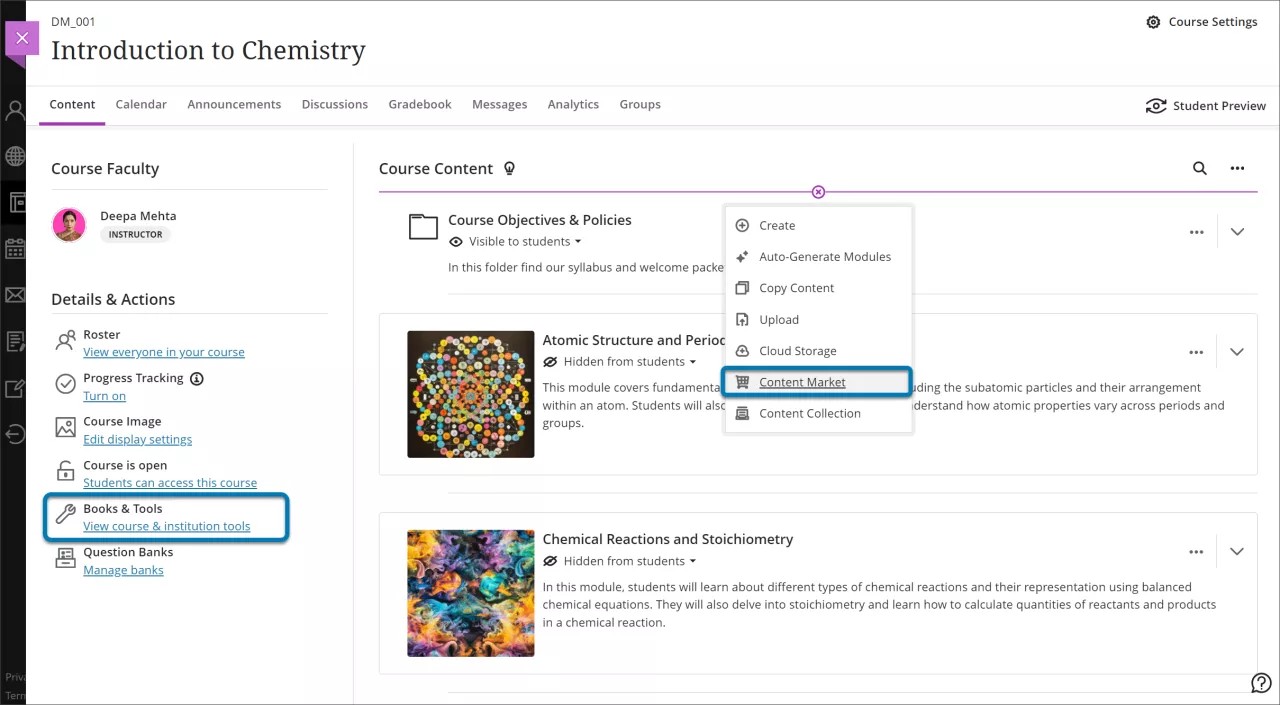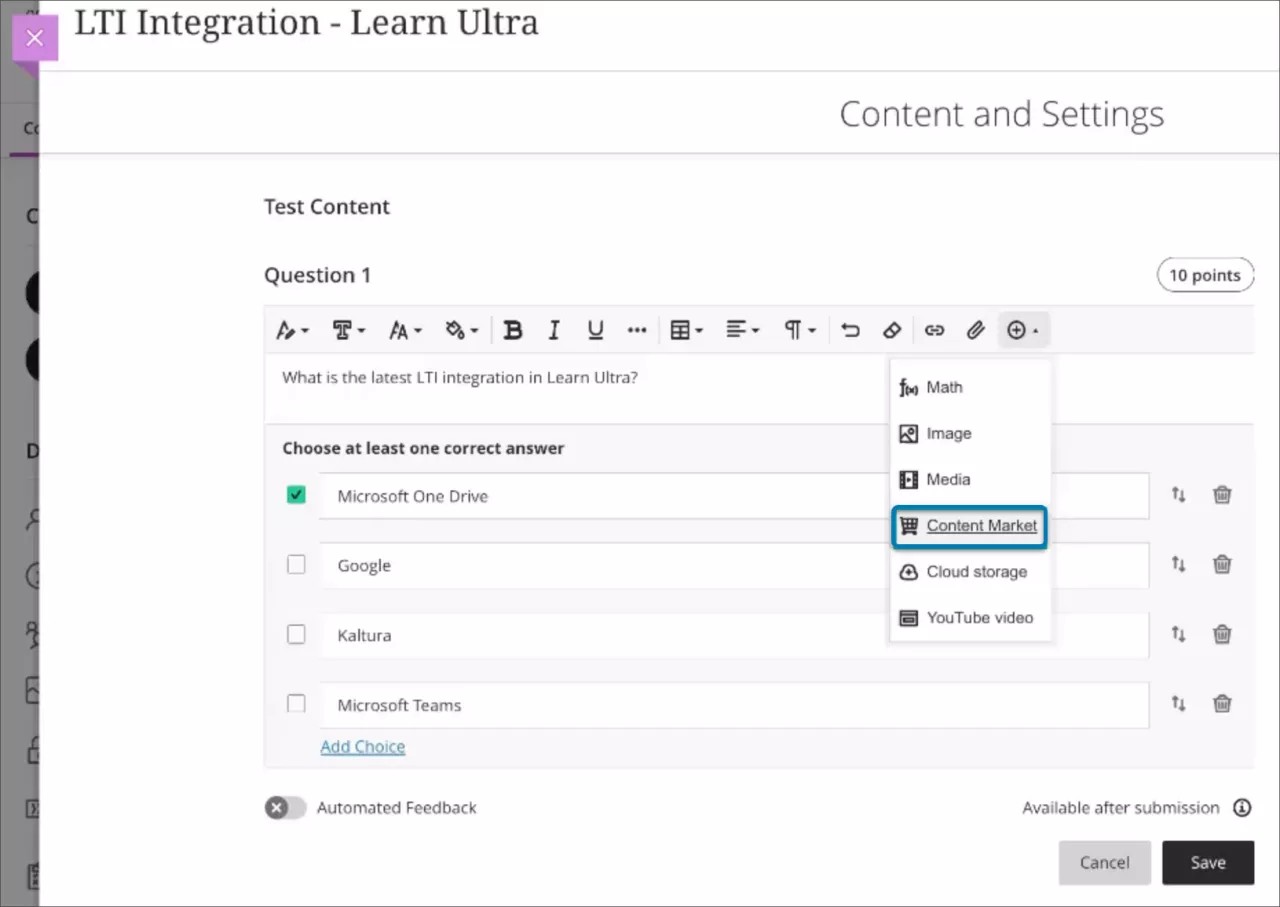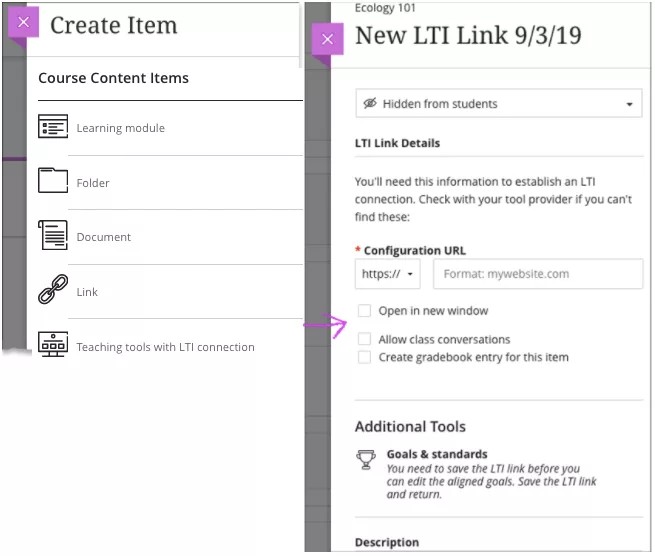Content Market
The Content Market is your gateway to access valuable learning materials from content providers. You can also access tools and links that your administrator has made available across your institution.
The content and tools you add appear on the Course Content page alongside your other course materials.
- On the Course Content page, select the plus button wherever you want to add content.
- In the menu, select Content Market. You can find and add content from content providers or browse the list of tools your institution has already made available.
- Choose a publisher textbook and electronic resources. Then, pair your course to that publisher with the authorization process required by that publisher. You may be asked to authorize the provider's access to certain user information, such as your name and email address.
Your institution may choose to automatically share your user information with content providers.
- Select Launch.
At the start, you provide your publisher credentials and receive access to the textbook. Then, you can continue to access materials and tools throughout the term. After you add materials to your course, you can organize them as you want and show them to students when you're ready.
You can also add content from the Content Market directly to the editor in your course's assignments, tests, and documents. In the content editor, select Insert Content (the plus button), then Content Market from the dropdown menu.
Once you’ve created a content item, you can edit it by selecting the ellipsis menu button on the newly created content item. The edit settings include:
- Name/Title
- Description
- Visibility including Release Conditions
- Option to Launch to the tool
- Open in a New Window
- Enable Class Conversation
- Grade information if Partner Content is gradable
- Goals & Standards
If the partner content is gradable, the due date and grade maximum are read-only. These are only configurable within the Partner Cloud tool.
More on adding Content Market files in the editor
Institution Tools
You may also have access to content and tools your institution has added.
Your administrator can authorize resources with Learning Tools Interoperability (LTI) technology. LTI is an initiative managed by the IMS Global Learning Consortium to seamlessly integrate externally hosted web-based learning tools into courses.
On the Content Market page, you can select your institution's Class Collaborate session manager if it appears. In the panel, you can manage visibility, rename the tool, and type a description that appears on the Course Content page.
Add teaching tools from the provider's site
If a tool provider allows, you can add multiple pieces of their content to your course.
On the Course Content page, select the plus button wherever you want to add content. In the menu, select Content Market. Find the tool provider, launch the tool, and start browsing for content.
Every tool provider's content is configured differently. You may see a check box next to content items. Select all to add all in one action. Contact your institution to learn more about adding third-party content to your course.
Books and Tools
On the Course Content page in the Details & Actions panel, select Books and Tools. You can view the publisher content you've already used in your course and tools you may be interested in.
The list of suggested tools contains the authorized tools for your institution, such as Class Collaborate. Select the plus button to use a tool in your course.
For example, you can set up a shared class notebook. You can also grade contributions and add a due date so the required work appears on students' calendars. Simply add it to your Course Content page and configure it based on instructions from the tool provider.
Add teaching tools with the LTI connection
You can also set up tools your institution hasn't authorized yet. For tools integrated with the LTI standard, add the LTI connection information. From the Course Content page, select the plus button, then Create from the drop-down menu. From the Create Item panel, select Teaching tools with LTI connection.
On the New LTI Link panel, title the tool and type or paste the Configuration URL. If the LTI connection requires a key or a shared secret, these fields appear after you add the URL. You can also set the link to open in a separate window, allow class conversations, enable grading, and type a description that appears with the tool on the Course Content page. If you don't add a title, New LTI Link and the date appear in the content list.
Your institution decides which LTI providers are acceptable and may limit external connections.
When students select the link on the Course Content page, they're brought to the content.
You're alerted and the link is hidden from students if the configuration is invalid or requires approval by your institution.
To learn more about our integration partners, visit the Anthology App Catalog.
Align your LTI teaching tool with a goal
You can align an LTI link to one or multiple goals. You and your institution can use goals to measure student achievement across programs and curriculums. You need to save the LTI link before you can align goals.
On the Course Content page, access the LTI link's menu. Select Edit, and then select Align with goals to search for available goals to align with this item. Students can't see the goals you align with an LTI link.
More on how to align goals with course content
Add your LTI teaching tool to the gradebook
You can add the LTI link to the gradebook. After students complete a submission and receive a grade in the LIT teaching tool, the gradebook is updated.
- In the LTI Link Details, select the Create gradebook entry for this item check box.
- In Due Date, add a date so the required work appears on students' calendars.
- If you choose, set the Grade using, Maximum points, and grade category.



